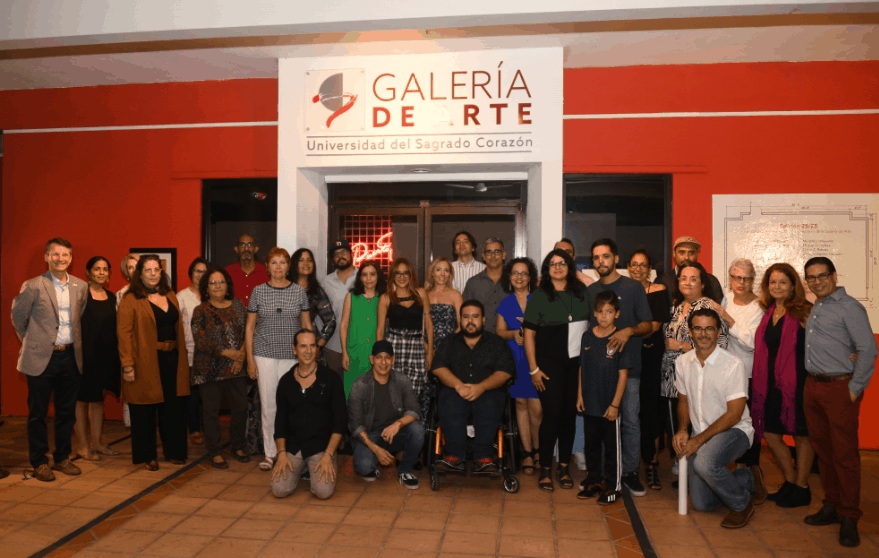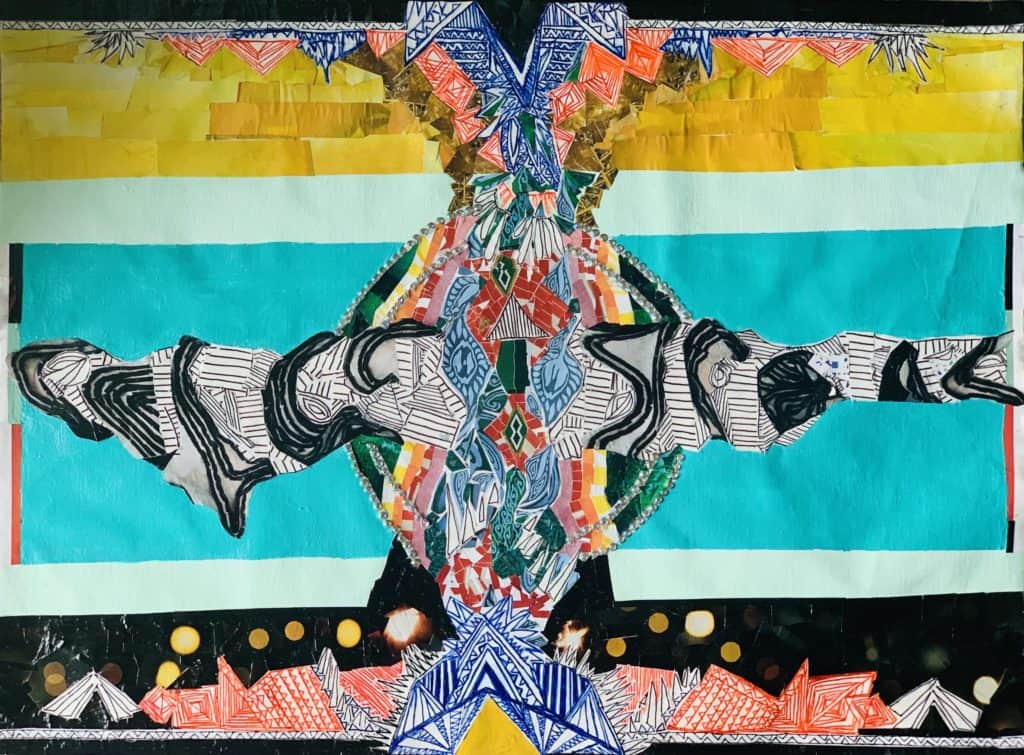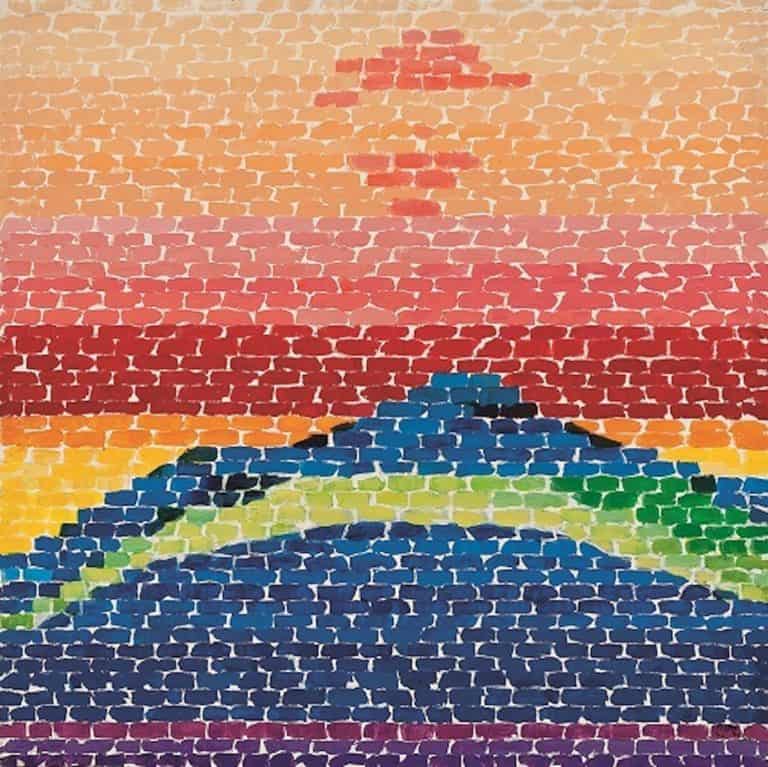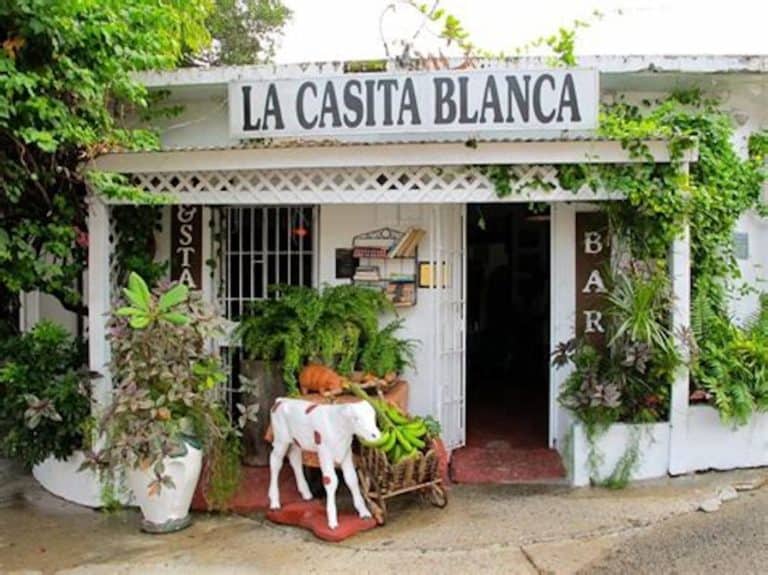The director of Galería de Arte, Norma Vila, interviewed Amber Robles Gordon, our visiting artist.

By Norma Vila
Director of Galería de Arte
The Galería’s programming for this academic year 2019-2020 had to be powerful since it would coincide with its 25th anniversary.
In order to celebrate it, we decided to take some concrete steps and began by accommodating the first retrospective exhibition by the well-known filmmaker and Sagrado faculty member, Sonia Fritz. The exhibition was curated by Margarita Fernández Zavala and intertwined two themes of utmost importance for the filmmaker, and of vital importance to our community, the women’s rights and migrant groups’ experiences. The Gallery was transformed into a cinema hall, where the visitor could enjoy a selection of 23 of Fritz’ documentaries.
This was followed by the harmonious, versatile and thoughtful work of one of the pioneering teachers of our Visual Arts program, the artist Diana Dávila. The importance of her exhibition Tangible and Intangible resided in the fact that for the first time the visitor could see how an idea (intangible) materialized (tangible) through Davila’s talent from the original sketches and drawings to paintings, ceramics, and jewelry. Students and the general public were captivated by this mastery of techniques and concepts.
At the beginning of the second semester, as the Gallery’s anniversary date approached, the group exhibition Edition 25/25 began. It is a selection of the works of twenty-five alumni who have excelled in their achievements in the local and international visual arts scene. Their proposals range from the most traditional, such as screen printing, to more contemporary pieces that use using virtual reality and gif animation as a medium. Sagrado’s Provost, Dr. María Teresa Martínez Diez, highlighted that in its quarter of a century of life “the Galería has fulfilled its commitment of identifying the local cultural and creative industry’s production and exhibiting it. On this occasion we honor those who once received inspiration from it and today share their talent with pride.”
Since its inception, the Galería’s mission has been to offer the university and general public a heterogeneous program that researches and documents current humanistic issues through Puerto Rican art. Beyond working the heterogeneous within the artistic manifestations, as an institution driven by its civic and academic mission, we have opted to provide space to projects and artists whose voices promote social justice issues. Intersectional topics such as gender, race, beliefs, values, and our diaspora are included in the Galería’s program and it becomes a teaching-learning laboratory for faculty and students. The Galería affords the opportunity to create interdisciplinary experiences and strengthen analytical and creative thinking.
But how to expose them to what happens outside the island? For this academic year, the Gallery decided to launch a visiting artist program and selected Washington, D.C.-based Afro-Puerto Rican artist Amber Robles Gordon. Having a visiting artist contributes to the training of students far beyond a class, it functions as an on-site journey, and strengthens ties with the community. Most importantly, visiting artists bolster our vision of lifelong education by challenging the “right answer” framework that limits the teaching and learning experiences.
At the beginning of the academic year, Robles-Gordon visited the island for the first time since she left Puerto Rico when she was very young. As our invited artist, she lodged at a residence adjacent to the campus, and gave a series of conferences to various groups of students. Her second visit to Sagrado was on November when gave a conference based on her work and artistic professional practice. She expounded on how she has broken with the stereotypes of Afro-Latin-American women and artists and how she uses her profession as support and defense of social justice.
Amber Robles Gordon is an artist known for recontextualizing non-traditional materials at different scales from two-dimensional artwork to her public works of art. Her intention is to emphasize the essentiality of spirituality and temporality within life. Robles is driven by the need to build her own distinctive path, innovate and challenge social norms, which is why her artwork is unconventional and unformulated. Her creations are representative of herpersonal experiences and the paradoxes within the imbalance of masculine and feminine energies in our society. Ultimately, she seeks to examine the parallels between how humanity perceives its greatest resources, men and women, and how we treat our possessions and the environment.
From the experience of visiting the island she created a corpus appropriately titled “A Place of Breath and Birth” which was to be exhibited in April 2020. However, this was cut short due to the COVID-19 pandemic. The solution to this problem was to present her work in a virtual fashion.
Having the opportunity to coordinate her two visits to our campus, exchange experiences, listen to her motivating lectures, and see in her recent artistic production, sparked in me the desire to interview her. I hope you can get to know more about Amber Robles Gordon through this conversation.

N: Place of Breath and Birth is the title of your recent production developed in Puerto Rico. Would you please elaborate on the significance of the name?
A: The title literally came from my desire to know more about where I was born and where my mother spent her childhood. Puerto Rico (PR) is both my place of birth and the place where I drew my first breath. At the time of my birth, most of my family – maternal and paternal – lived in St. Thomas, Virgin Islands. I spent the first two years of my life in St. Thomas and then moved with my mom and dad to Washington, DC. My mother—the primarily link to my birthplace—taught me Spanish and kindled my identification with ‘La Isla”. During my 2019, trip, I began my search for family members who still resided in PR. I felt that this search would cultivate a deeper relationship with Puerto Rico.
After my two visits to Puerto Rico in late 2019, I decided in early 2020 to rent an apartment in Puerto Nuevo to start producing the series “A Place of Breath and Birth.” Due to the persistent earthquakes, and the risk that they represent for the Sacred community, my exhibition was postponed, later with the start of the COVID-19 pandemic, everything worldwide changed and I had to return to Washington D.C. New works produced under the title A Place of Encouragement and Birth were moved to an online platform.
This would be my first opportunity to exhibit in the Caribbean and deepen my relationship with my birthplace, Puerto Rico, “La Isla del Encanto”. That is why I have titled the exhibition, Place of Breath and Birth. This was my original statement as an artist that gave rise to this series and it is still burning and guiding my discovery daily. The intention of the proposal for an individual exhibition at P.R. was to empower my five-year-old self. To give her the strength to fight for herself, her language and culture. I was born in San Juan, Puerto Rico and raised in Arlington, Virginia. My first language was Spanish, yet at about five years old, I came home one day and told my mother: “I was not speaking Spanish anymore”. From then on, I responded to my Spanish/English speaking mother in English only. Later, I came to understand that I had surrendered my Spanish tongue—a critical part of my cultural identity— so that I could “fit” a version of myself that could possibly coincide with the prescribed box that others had for a brown-skinned girl such as myself. Although in time, the name calling ceased, however, the micro-aggressions, insensitive questions, assumptions, and judgments about my brownness lingered. Throughout this life, time-after-time, I have had to choose to identify with my brownness/blackness over the other cultural ties that bind other Spanish speaking people with their culture.
Although, my personal narrative is the main focus of these works of art, I will continue to contextualize it within the political, socioeconomic, and environmental threads that define and are often used to control, alienate, or mistreat Puerto Ricans in general and Afro-Puerto Ricans. in particular. Also, my artwork is about the intersections of femininity, patriarchy, hybridism, and Americanism. Ultimately, I hope this narrative and this work of art will give voice to others who walk in shades of brown, who breathe within a feminine form and who do not conform to the rules… but are bold and proud.

N: That visit in September 2019 was your first visit to Puerto Rico. How was that first encounter?
A: Technically, my two-week trip to PR in September 2019, was my first trip there as an adult. My mother told me that I have been to PR as a young child. However, I truly had no memory of those visits. During the first trip, accompanied by my mother, we realized this was the first time we traveled alone together. I had my mother all to myself! She is an amazing human being: She is always working, helping family, friends and organizations and causes that that concern her. She is always DOING something. Thus, being able to spend time with her exploring the Sagrado Corazon’s campus, local art museums and galleries, El Yunque National Rain Forest, and other places imprinted on my mother’s childhood was immeasurable. Moreover, I meet my boyfriend during this trip. So I have many good reasons to celebrate having been able to visit the island.
N: As our visiting artist you offered a presentation to 3 groups of the Art Program of the University. For those who weren’t there, would you elaborate on how you integrate your origins and beliefs with the use of various materials and vibrant colors?
A: I believe following one’s authentic internal voice is an essential part of integrating ones’ origins and beliefs and projecting this awareness into the use of whatever medium and or methods you choose to create with or live by. Creating art, is an essential method of self-joy and self-expression, and a means for sharing my concerns and connecting to a higher power.
I have known, I would be at artist since I was eight years old. Beyond being loved and cherished by my mother and father as a child; the other activities that triggered an innate and immediate positive response, was being encouraged and praised for my creativity. I recall the feeling of pride when my first or second-grade art teacher praised my artistry or being allowed to hang my artwork in the lobby of our apartment building—the Brittany, Arlington, VA—as a teenager. My life experiences have been intricately connected to my love of art and creating.
I was also encouraged to defend or advocate for the rights and appropriate treatment of myself and others. I have vivid memories, of getting in trouble, especially in school, for the right to speak my mind and claim my agency over my body and voice. I objected to middle school boys who slapped the derriere’s or snapped the bras of the girls they “liked”. I recollect the sting of the slap and my disappointment, as the school’s vice-principal referred to these personal infringements, as love-taps. I remember the anger welling up inside me, from being chastised and or punished for yelling at or chasing the perpetrator. It was clear that the boys were not held to the same standards of behavior as the girls. These and other experiences throughout my childhood unveiled deep seated gender variances and stirred a desire to explore the underpinnings of gender inequality, which is embedded throughout my artwork.
During my graduate experience at Howard University, I was exposed to different philosophers and their views. In fact, the renowned debate between Black philosophers, Alain LeRoy Locke and W.E.B. Du Bois regarding art as a form of individualistic and aesthetic expression, or art as propaganda to contribute to racial advancement and group expression was particularly meaningful for me. This debate further reinforced the importance and privilege of my own creativity and creative process. Using my art to give voice to others and further define my agency as women of color became even more fundamental.
N: How did visiting and living for a short time in Puerto Rico influence your work? How does this series titled A Place of Breath and Birth differ from your previous artwork?
A: I have wanted to create work about PR for most of my adult life. Growing up in the states away from most of my family and Caribbean life, has fostered a longing for a pilgrimage to Puerto Rico, Antigua, Tortola, BVI and eventually trace my roots to Africa. I initiated this process in September 2016, by reaching out to Edwin Velazquez Collazo, founder/writer of the art-blog, Puerto Rico Art News, and shared my art portfolio and my desire to exhibit in PR. Since then, we checked in periodically, and in late 2018, Edwin identified an opportunity and put me in contact with you Norma Vila, (director of the Gallery) of the Galeria de Arte in Universidad del Sagrado de Corazón.
After visiting in September and November 2019, I decided to return to the island in early 2020 to live temporarily. Being in PR allowed me to focus on cultivating a specific atmosphere and environment to create and live within. I choose a third-floor apartment with two bedrooms and a sunroom and awarded myself the largest and brightest room —the sunroom— as my studio. It has four large windows and exposure to three-dimensional light every hour of the day. We filled the studio with about thirty-eight variations of plants, a futon, a printer, a storage shelf, and of course my artwork. While sitting on my futon I could watch the palm trees bend and dance to the shifts and variances of the changing weather. The standing view revealed both my immediate block life, vibrancy, greenery, music, and the loud barking little dogs below. Because I can see above all the other two-story buildings, I have an expanded vista, about 3-5 miles out, I can see the outdoor potion of the Tren Urbano, PR’s transit system. Then, about 15-20 miles away, I can see the outer fringe of city-life with looming lights and high rises.
These variances of space, environments, and time influenced this body of artwork by effecting my interpretation of and relationship to spatiality. In these pieces, I convey both my internal feelings and external environment by the layer of materials so that they create divisions depicting various planes of existence throughout these compositions. This formula allowed me to manifest multiple representations of atmospheric ecosystems. My time in PR provided the environment and time, to focus on expanding my perspective of and a sense of ownership of self, of land, culture and of elements through landscape. In this context, my commitment to sketch at least every other day, yielded sketches, primarily a combination of line drawings and geometric shapes, which lead to sacred geometry like renderings and some figuration. Later, these sketches from integral parts of the overall design of the entire series.
N: Sometimes as artists we devise a platform and strategies that later require adapting the idea to the circumstances. This project has not been unrelated to circumstances beyond our control (earthquakes, power outages, COVID-19). Do you consider that these circumstances have had an impact on the development of your work, be it emotional, mental, or cultural?
A: I have had to be malleable in my behavior and expectations regarding this exhibition and about the circumstances that impacted this endeavor. However, my level of commitment to the process and the incremental revelations that surfaced during my time in PR were so defining and nourishing, I had no choice but to move forward.
N: Referring to the title of your project A Place of Breath and Birth. Do you still think Puerto Rico is a place of breath? And, if so, in what sense?
Puerto Rico will always be my Place of Breath and Birth, and I welcome opportunities to continue to learn about, build community and experiences to further know that part of myself and heritage.
I also become aware that, I am imprinted by my mom’s memories of her childhood home. During my visit, I witnessed the change in accent and the increased level of attachment and comfort she felt in PR. Apparently, this was also observed by you, Norma (director of the Gallery), I remember you mentioned that she sounded more Puerto Rican every day on the island. I think I also witnessed the charm of the island through the way my mother felt – how she cooked, danced, and delighted in her Afro-Latinity; all the things that have influenced my sense of identity.
COVID-19 Times
N: How was your studio practice interrupted by the lockdown? How has your work changed because of the lockdown?
A: Yes, there was an interesting continuum of things in life that impacted my production in the studio, in my life and even in the planning of this project during these first months of 2020. I used the first phase of my residency on the island to locate my house and my studio in Puerto Rico, which took longer than expected due to the tremors. Once I was located in my apartment, I began the second phase; exploring, photographing, and searching for resources to incorporate into the art. Then, the lockdown happened, and another level of limitations ensued.
In Puerto Rico, the quarantine was extremely strict. Most businesses were required to shut down. Only, the local government, supermarkets, some restaurants (mostly fast food establishments) and pharmacies could remain open. I could no longer go to the art supplies store when I needed supplies. Yet, I still had deadlines to meet for upcoming exhibitions and or projects. I had to conform myself to using whatever was already in my possession to create this body of artwork.
N: What are you working on right now ?
A: Right now, I am working on artwork for my solo exhibition, Secession, at Katzen Center, in the American University in September 2020. The Place of Breath and Birth series will also be a part of that exhibit. This exhibit will also include the other set of artworks, 8-10 quilts, I worked on while in PR.
N: What are you reading, both online and off?
A: I am not an avid book reader. More often, I listen to audio books and or listen to informational videos. I recently, read INSERT A BOOK AND AUTHOR HERE, accessed through my car audio, was completed during multiple errands. I also spend a lot of time reading online articles about art in general from a select number of online art publications: https://hyperallergic.com, https://bmoreart.com and https://www.artsy.net. Daily, I read numerous online articles and posts about current issues, such as politics and social justice issues and happenings.
N: Have you visited any good virtual exhibitions recently?
A: I was drawn-in by the work of María Magdalena Campos-Pons, Untitled, from the series When I am not Here, Estoy allá, 1996. The exhibit also features artwork by James A. Porter and Carmen Lomas Garza.

With the term “self-conscious” as its starting point, the exhibition Eye to I is a cherry-picking of self-portraits by major artists in the Smithsonian’s National Portrait Gallery. With a wide range of depictions spanning over a century, this thoughtful presentation straddles themes from cultural identity to body positivity. Catch up with it in this six-minute video tour.
N: Have you taken up any new hobbies?
A: Honestly, although I am now back in DC and I have not had the time to start a new hobby yet. Most of my time is divided into creating artwork, administrative tasks, cooking, grocery shopping, exercising and spending time my family and love ones.
N: What is the first place you want to travel to once this is over?
A: Huh, that is a good question. Since 2015, I have traveled to Thailand, Italy, Miami, Morocco, and Puerto Rico. So, although I absolutely welcome the opportunity to travel again, I do not have a specific place in mind as of right now. Future plans include continuing my familial pilgrimage, by spending more time in Puerto Rico, visiting Tortola, and then tracing my African roots.
N: If you are feeling stuck while self-isolating, what is your best method for getting unstuck?
A: I am fortunate that my self-isolation has included my boyfriend and my mother, brother and niece who live a few blocks away. So, when I am feeling stuck or frustrated, we go for a walk, visit family, plant some plants, or simply watch a good Science Fiction movie.
N: What was the last TV show, movie, or YouTube video you watched?
A: Right now, we are watching the Star Trek Discovery series. In mid-May we gathered at my mom’s house on a Sunday evening and made a YouTube collection of the songs she would play (vinyl long-playing 45s records) on either Saturday or Sunday mornings before we did our chores. This collection included songs from when we were between 5 to 17 years of age. Among them are: “I love Trash”, “ I left my Cookies at the Disco” by the Sesame Street crew; three of Tracy Chapman’s 1988 chartbusters: Fast Car and Talkin’ Bout a Revolution, and Mountains o’ Things. On the Latin side we focused on Juan Luis Guerra y 440’s Ojalá que llueva Café, Bachata Rosa, and Burbujas De Amor; and Puerto Rican Yomo Torro’s “Don’t Bury my Clothes”.
N: If you could have one famous work of art with you, what would it be?
A: I would love to live with Alma Thomas’ Apollo 12 “Splash Down,” 1970. I was eight years old when I first saw Alma Thomas work. My mom, then a student at Georgetown University, was taken a course on African American Art, which included a project to see Thomas’ work exhibited at Howard University. My mom says I stood in front of her work—my eyes huge while holding my breath—mesmerized by her work.

N: What are you most looking forward to doing once social distancing has been lifted?
A: Recently, I have been craving tuna salad sandwiches from El Meson or the “Tres Leches” dessert at La Casita Blanca, local bastions of Puerto Rico’s Cocina Criolla (traditional Puerto Rican cuisine). Also, I hope that I can attend my opening at American University in fall, 2020.
